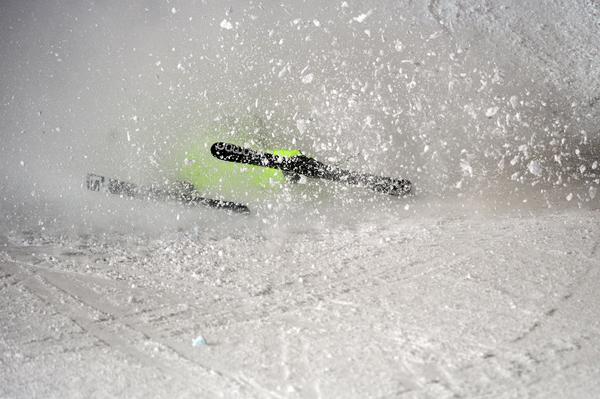
Bobby Brown slides down the hill after wiping out in the men’s ski big air finals at the Winter X Games. The use of an airbag in training can help develop the body mechanics needed for big tricks, but it also increases the risk for athletes striving for glory in action sports now defined by increasingly technical and dangerous tricks. (Photo by Daniel Petty/The Denver Post)
By Jason Blevins
The Denver Post
Backflips are taking over skiing and snowboarding. Spinning double and triple-corked trickery was the golden ticket in every competition at last weekend’s X Games in Aspen.
The sketchy-to-learn tricks have expanded the training toolbox for athletes to include massive airbags.
Superstar Shaun White honed his triple-cork on a private airbag at Breckenridge. His airbag training at a private pipe at Silverton Mountain in 2010 greased his way to Olympic halfpipe gold that year. Today, the massive bags aren’t just for the pros but also the young aspirants nipping at their heels.
“It’s just changed everything. It’s so valuable and such a great in-between step, that difficult step between imagining a new trick and actually doing it. Now we can have the luxury of taking that step and not get hurt,” said Aspen’s Gretchen Bleiler, who sessioned an airbag at Mammoth Mountain ski area two weeks ago as she regained her snowboarding pipe form after suffering an eye injury while training on a trampoline.
An airbag can help develop the body mechanics needed for, say, spinning 1,620 degrees while backflipping three times off a 100-foot jump. But it also ups the risk for athletes striving for glory in action sports now defined by increasingly technical and dangerous tricks.
“I guess it’s allowing for the sport to progress to a place it probably never would have been,” Bleiler said.
Still, not all athletes think hucking massive tricks into inflatable bags is the best way to develop.
Henrik Harlaut, the 22-year-old Swede skier who won X Games big air gold with the most stylish, technical tricks ever seen in competition, has never used an airbag.
“I only use snow. I always wait to try a trick until I really know that I’m ready to land on my feet,” Harlaut said.
An airbag requires athletes to land on their backs, forcing them to change their approaches when it comes time to land on snow.
“I don’t think — for myself — that’s a good way to practice because you learn your rotations to land on your back,” Harlaut said. “I’d rather just go to snow and just commit to it.”
Mark McMorris,the Canadian teenage snowboarder, won his second slopestyle gold medal Saturday with a bomber triple-cork 1260 that earned an X Games record 98 points. He says airbags are “pretty dangerous” and that he learned his trick on snow.
“I think airbags can put you into bad habits, but some people they work for,” said the 19-year-old whose triple-cork earned big air gold in 2012 but only silver in Friday night’s big air contest.
Kaya Turski,the decorated 24-year-old Canadian slopestyle skier who won silver at Sunday’s X Games, said more women are using airbags to develop the off-axis, double-cork tricks that remain rare in women’s skiing and snowboarding competitions.
“I think they definitely help,” Turski said. “If you are landing on your head, I think you are better off landing on your head on an airbag.”
Elana Chase, the vaunted freeskiing coach at the Vail Ski & Snowboard Club, said an airbag helps with the final step in developing technique.
“You should have that trick 90 percent of the way before you take it to the airbag,” Chase said. “The majority of your work should have already been taken care of in the gym, on the trampoline, water ramps, watching other tricks and learning the mechanics and building up. It’s a great tool, but not the only tool.”
Jason Blevins: 303-954-1374, jblevins@denverpost.com or twitter.com/jasontblevins
